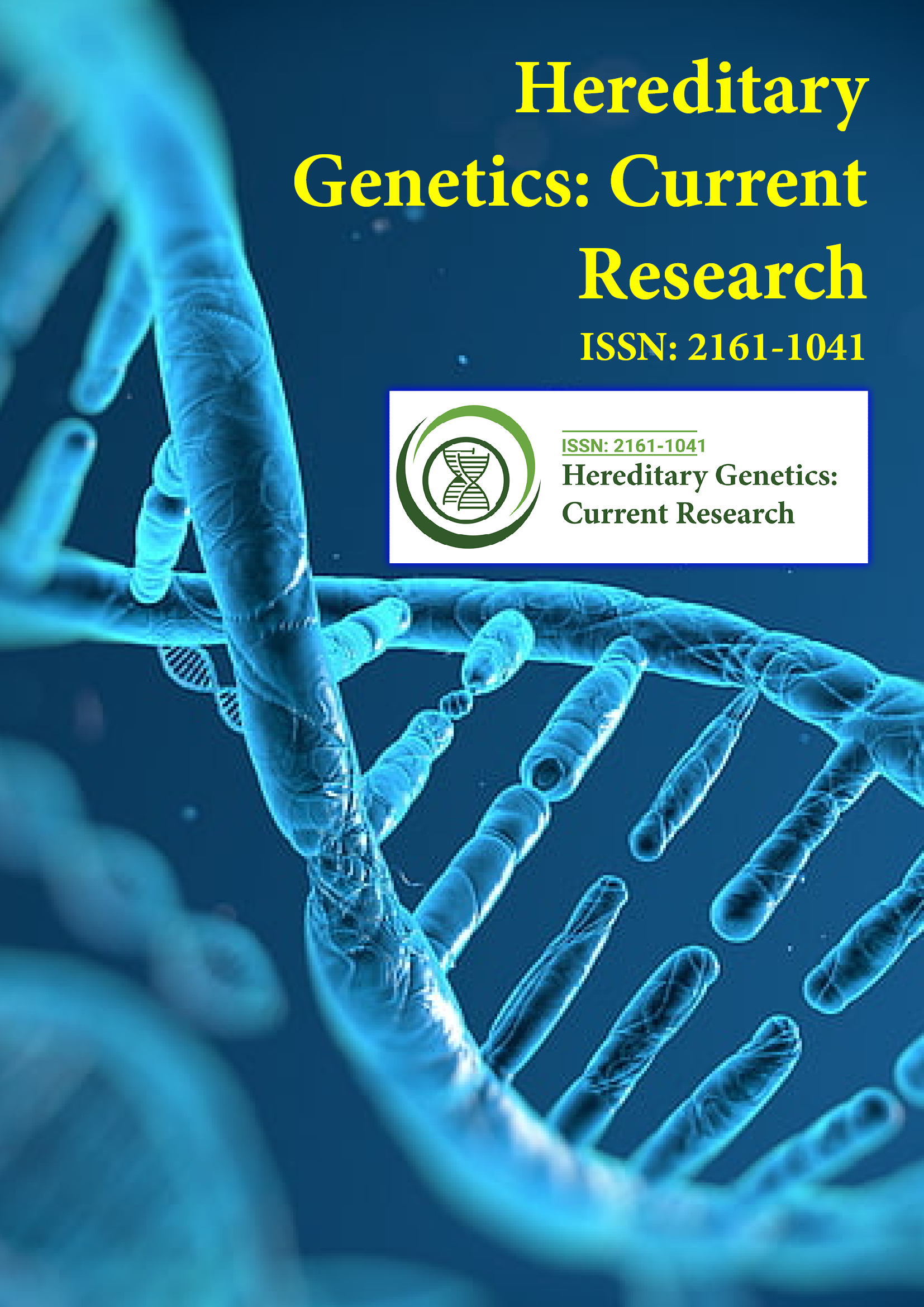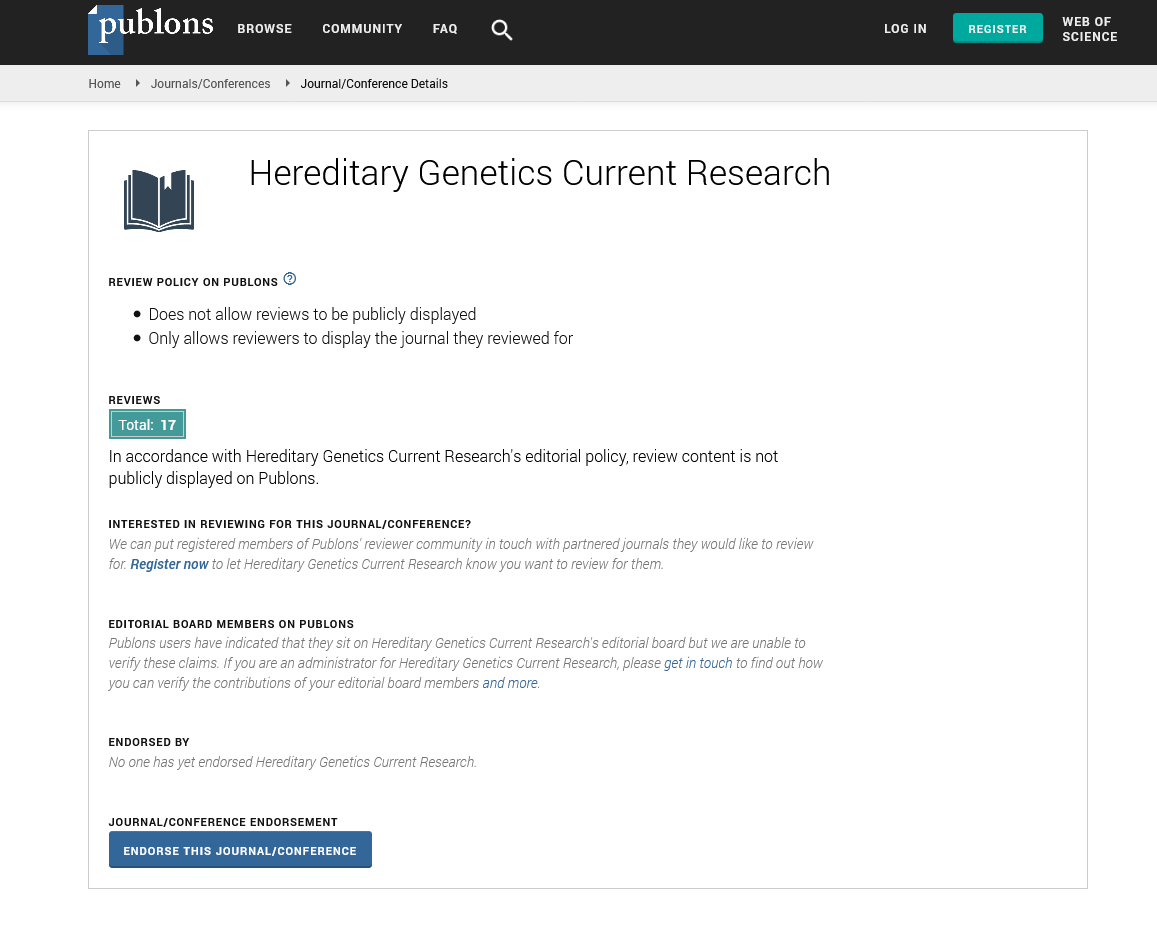PMC/PubMed Indexed Articles
Indexed In
- Open J Gate
- Genamics JournalSeek
- CiteFactor
- RefSeek
- Hamdard University
- EBSCO A-Z
- NSD - Norwegian Centre for Research Data
- OCLC- WorldCat
- Publons
- Geneva Foundation for Medical Education and Research
- Euro Pub
- Google Scholar
Useful Links
Share This Page
Journal Flyer

Open Access Journals
- Agri and Aquaculture
- Biochemistry
- Bioinformatics & Systems Biology
- Business & Management
- Chemistry
- Clinical Sciences
- Engineering
- Food & Nutrition
- General Science
- Genetics & Molecular Biology
- Immunology & Microbiology
- Medical Sciences
- Neuroscience & Psychology
- Nursing & Health Care
- Pharmaceutical Sciences
Perspective - (2023) Volume 12, Issue 3
Genomic Revolution: Advances in Understanding the Molecular Basis of Inheritance
Sergio Fonseca*Received: 01-Sep-2023, Manuscript No. HGCR-23-22977; Editor assigned: 04-Sep-2023, Pre QC No. HGCR-23-22977 (PQ); Reviewed: 18-Sep-2023, QC No. HGCR-23-22977; Revised: 25-Sep-2023, Manuscript No. HGCR-23-22977 (R); Published: 02-Oct-2023, DOI: 10.35248/2161-1041.23.12.253
Description
Inheritance is a fundamental biological process by which genetic information is transferred from one generation to the next. In order to solve the challenges of genetics, it is essential to recognize how this information is encoded, transported, and expressed at the molecular level. The molecular basis for inheritance investigates into the intricate mechanisms by which genes, composed of DNA, contain and communicate genetic information, and how this information is reliably transferred through the processes of replication, transcription, and translation. This process occurs during the S phase of the cell cycle and involves the unwinding of the DNA double helix, the synthesis of complementary strands, and the proofreading mechanisms to correct errors. The replication process is initiated at specific sites on the DNA molecule called origins of replication. Enzymes, such as helicase and DNA polymerase, join to unwind the DNA and synthesize new strands. One strand, known as the leading strand, is synthesized continuously in the 5' to 3' direction, while the lagging strand is synthesized in short, discontinuous fragments known as Okazaki fragments. DNA ligase then joins these fragments, creating a complete, newly synthesized DNA molecule.
Errors during replication are rare but can occur. DNA polymerases possess proofreading capabilities and can correct mismatched base pairs. Additionally, the mismatch repair system scans the newly replicated DNA for errors and corrects them. These systems guarantee that genetic information is properly transmitted from one generation to the next, with an error rate of around one in a billion base pairs. The molecular basis for inheritance not only encompasses the mechanisms of DNA replication, transcription, and translation but also explores the intricate relationships between genotype and phenotype in organisms. Understanding these correlations is essential for decoding how genetic variations lead to the diversity of traits and characteristics among individuals. Genotype-phenotype correlations are complex and can be influenced by various factors, including genetic variation, environmental factors, and gene interactions. Some genetic variations have an obvious correlation with phenotype. However, many traits are influenced by multiple genes, a phenomenon known as polygenic inheritance. Height, for instance, is determined by the interplay of numerous genes, each contributing to a fraction of the overall phenotype.
Environmental factors, such as nutrition and exposure to toxins, can also interact with genetic factors to influence phenotype. Additionally, some genetic variations may be silent, meaning they do not result in observable changes in phenotype. These variations can still have important implications for an individual's health or susceptibility to certain diseases. The molecular basis for inheritance also plays a role in understanding the genetic underpinnings of various diseases.
Many diseases have a genetic component, meaning that they result from mutations or variations in specific genes. These genetic factors can influence an individual's susceptibility to a particular disease and the course of the disease. Mendelian disorders, such as cystic fibrosis and sickle cell anemia, follow classic patterns of inheritance and are caused by mutations in single genes. In these cases, understanding the specific genetic mutation can provide valuable information for diagnosis, prognosis, and potential treatment strategies. Complex diseases, such as diabetes, heart disease, and cancer, involve the interplay of multiple genes, as well as environmental factors.
Identifying the genetic factors contributing to these diseases is a complex task that often requires large-scale genetic studies, including Genome-Wide Association Studies (GWAS). Advancements in molecular biology techniques have led to remarkable progress in understanding the molecular basis for inheritance. The approach of Next-Generation Sequencing (NGS) technologies has revolutionized the field of genomics, allowing for the rapid and cost-effective sequencing of entire genomes. This has simplified the identification of diseasecausing mutations and the characterization of genetic variation at an unparalleled scale. Additionally, advances in gene editing technologies, such as CRISPR-Cas9, have opened up new possibilities for modifying the genetic code. These tools hold potential for correcting genetic mutations associated with inherited diseases and exploring the functional consequences of specific genetic changes. Furthermore, the field of epigenetics has expanded our understanding of how environmental factors can influence gene expression and phenotype. Epigenetic modifications, such as DNA methylation and histone acetylation, can modulate gene activity without altering the underlying DNA sequence. By analyzing an individual's genetic makeup, healthcare providers can change treatment plans to match the patient's unique genetic profile, leading to more effective and personalized therapies.
Conclusion
The biology's understanding of trait encoding is supported by the molecular basis for heredity, which involves DNA replication, transcription, and translation. Genotype-phenotype complexities, shaped by genetic variations and environmental factors, focus inheritance's complex nature and its influence on traits and disease susceptibility. Exploring the genetic causes of diseases has wide-ranging effects on diagnosis, treatment, and prevention. Recent advances in genomics, gene editing, and epigenetics have increased our knowledge and provided the opportunity to personalized therapy. As genetics develops, it may provide greater understanding of how genes and environments interact.
Citation: Fonseca S (2023) Genomic Revolution: Advances in Understanding the Molecular Basis of Inheritance. Hereditary Genet. 12:253.
Copyright: © 2023 Fonseca S. This is an open-access article distributed under the terms of the Creative Commons Attribution License, which permits unrestricted use, distribution and reproduction in any medium, provided the original author and source are credited.

